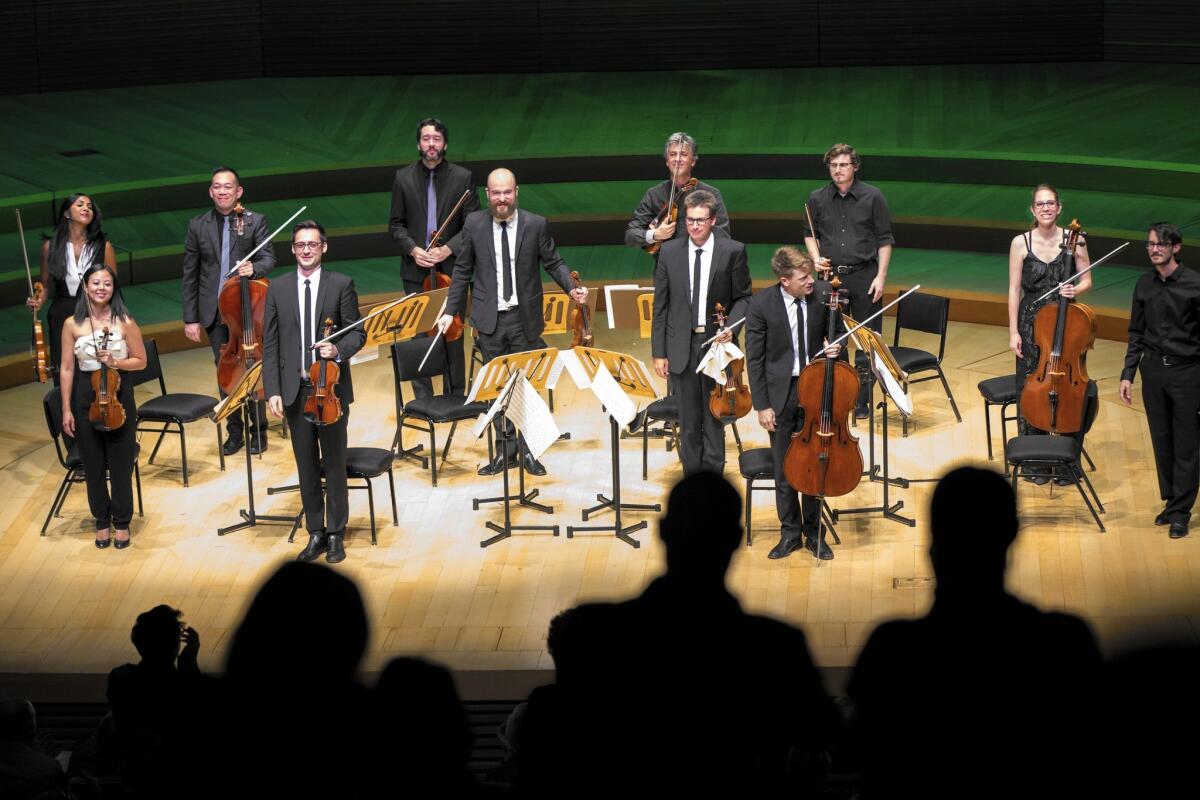Review: A quirky thread runs through L.A. Phil Green Umbrella quartet program

- Share via
Near the end of the Los Angeles Philharmonic Green Umbrella program Tuesday night, three local string quartets were arrayed on a darkened Walt Disney Concert Hall stage for George Brecht’s String Quartet. A spotlight illuminated the Calder Quartet, and the players stood and shook hands with one another. The Lyris Quartet and then the Formalist Quartet did the same.
Finally, everyone sat down, the full stage lighted. The players adjusted their scores and instruments, as if to begin. Then they all stood and happily began to hug one another, a full triple-quartet love-in.
This was the first time the L.A. Phil had presented in its new music series a piece by a Fluxus artist, a member of the 1960s neo-Dada anti-art (and anti-music) movement that included the likes Yoko Ono, Nam June Paik and Joseph Beuys — all musicians as well as visual artists. But possibly even rarer than a major orchestra acknowledging a Fluxus artist was such string-quartet fraternizing. That may be a true L.A. thing.
In most places, groups like the Calder, Formalist and Lyris aren’t likely to be quite so friendly. All three are relatively youthful quartets that have a strong relationship to contemporary music and their community, although the Calders (the only full-time quartet and the only one with an international reputation) cover the most extensive ground, from an ongoing Beethoven cycle at the Broad Stage in Santa Monica to pop arena and television appearances with the rock band Airborne Toxic Event.
In this case, the Calders pretty much took the lead. The L.A. Phil commissioned a new piece by John Luther Adams for the quartet, and the Calders also had a hand in the other commission, a triple quartet by Tristan Perich, who likes to play around with basic digital circuitry. Both happen to be composers of the post-John Cage generation, and a quirky Cagean thread ran through much of the evening.
The program began with an individual offering for each ensemble, starting with the Formalist playing a version of Cage’s “Music for Marcel Duchamp” arranged by Calder cellist Eric Byers. Surprisingly, Byers captured a sense of the original through pizzicato and added something wonderfully fresh with ghostly bowed harmonics.
The Calders and Formalists turned to senior American composers inexcusably neglected. The Calders’ contribution was “Edges” by Christian Wolff, the last surviving member of Cage’s New York School. In this version of a graphic score arranged by Chiara Giovando, penetratingly intense bowing came across as Bartok excellently disassembled.
The Lyris’ contribution was Ben Johnston’s String Quartet No. 4 “Amazing Grace,” in which the hymn goes through transformations in three different tuning systems. The quartet, frequently and rapturously played by the Lyris, reminds us of nine other neglected and extraordinary quartets by Johnston, who will be 90 in March. They could benefit from similar attention.
Adams’ “Canticles of the Sky” appears to be a new string quartet arrangement of an earlier piece for 45 cellos. (The L.A. Phil provided unusually unhelpful program notes.) The four brief sections contain beautiful musical meditations, lavishly consonant and strikingly tuned, on arctic sunlight, moonlight and starlight. The long tones and jingling small trills suit the lush Calders very well, but with a big cello festival coming up in Disney Hall next year, the original is what we really want.
Besides Brecht’s glad-handing, there were two actual triple quartets. Steve Reich’s, which is typically done with a single quartet playing against recordings of itself, may loose some pizazz as a 12-string chamber score, simply because strong amplification is part of the composer’s sound. But with the Calders as the lead in front and the other two quartets arrayed behind them, the audience got to watch really competent players sweat the metric torture without breaking. And it also got to hear how ingratiatingly lyrical the middle section can be when fully acoustical.
Perich’s new “Triple Quartet” did have an electronic element. Behind each player was a stand with a small loudspeaker that echoed each instrument. Perich may be today’s truest Minimalist in that not only is his style rhythmically and harmonically hypnotic but he also likes to keep his electronics as minimal as possible. The highest quality sound today relies on what is known as 32-bit architecture to process digital conversion. Perich likes it primitive, at one-bit.
In practice, this provided a buzzing electronic sheen to the three quartets with the loudspeakers seeming like aliens trying to mimic the language that violins, violas and cellos make. By the end, the electronics were in full body hugs with the three quartets.
More to Read
The biggest entertainment stories
Get our big stories about Hollywood, film, television, music, arts, culture and more right in your inbox as soon as they publish.
You may occasionally receive promotional content from the Los Angeles Times.











